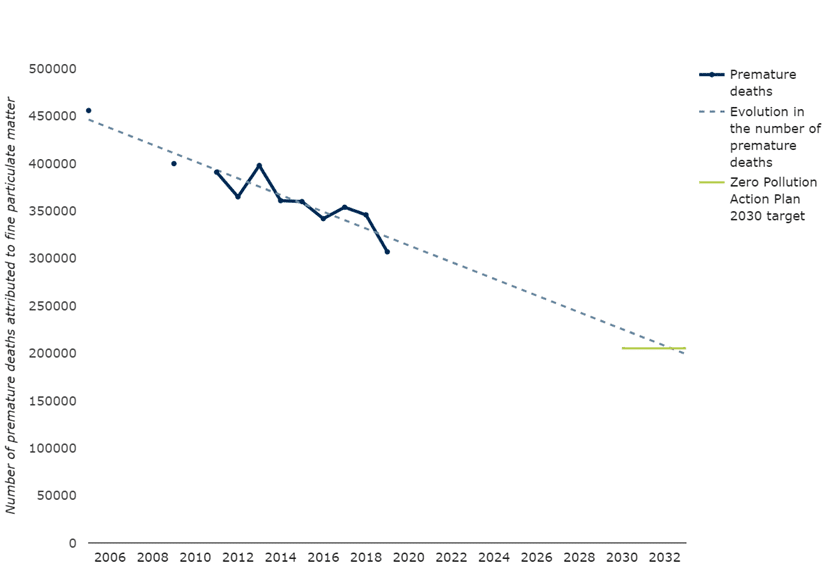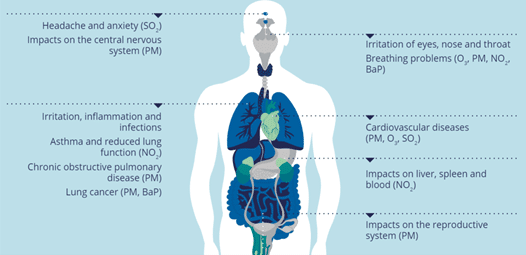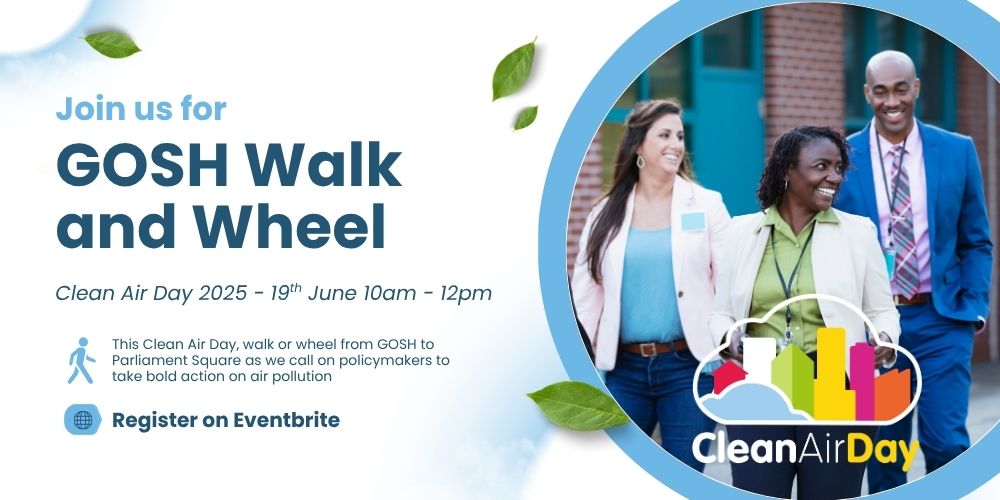
PM2.5’s – The Basics
5 January 2023
What is PM 2.5?
PM 2.5, also known as fine particulate matter, is a mixture of tiny solid particles and liquid droplets found in the air. These particles are 2.5 micrometers or less in diameter, which is about 30 times smaller than the width of a human hair.
WHO statement: “WHO Air Quality Guidelines for Particulate Matter, Ozone, Nitrogen Dioxide and Sulphur Dioxide” The latest WHO air quality guidelines (2021) recommend the following concentration limits for these pollutants:
PM2.5: annual average 5 μg/m3; 24-hour average 15 μg/m3.
PM 10: annual average 15 μg/m3; 24-hour average 45 μg/m3.
For NO2: annual average 10 μg/m3; 24-hour average 25 μg/m3.
Interim targets also exist to guide actions to protect health in places where air pollution is very high. This recommendation is not a safe value.
In fact, the World Health Organization has indicated that there is no evidence that there is a safe threshold below which exposure does not have the expected health hazard effects.
We need to understand the background of the “Air Quality Guidelines for Particulate Matter, Ozone, Nitrogen Dioxide and Sulfur Dioxide” published by the World Health Organization in 2005.
5 October 2006, Geneva — The World Health Organization today asked governments around the world to improve the air quality in their cities in order to protect people’s health. The WHO made the request when it unveiled its new air quality standards that drastically reduce levels of pollutants. The WHO believes that reducing levels of a specific type of pollutant, called respirable particles, could cut annual deaths in polluted cities by 15%. The standard also significantly lowers the recommended limit values for ozone and sulfur dioxide.
For the first time, the Air Quality Standards cover all regions of the world and provide uniform air quality standards. These standards are much stricter than the national standards currently in use in many parts of the world – which for some cities means reducing current pollution levels by more than three times.
The combined effects of ambient air pollution and household air pollution cause 7 million premature deaths each year. Household combustion appliances, motor vehicles, industrial facilities and forest fires are common sources of air pollution. Pollutants of major public health concern include particulate matter, carbon monoxide, ozone, nitrogen dioxide, and sulphur dioxide. Outdoor and indoor air pollution causes respiratory and other diseases and is an important source of morbidity and mortality. WHO data show that almost the entire population (99%) of the world breathes air that exceeds WHO guidance limits and contains high levels of pollutants, with low- and middle-income countries experiencing the highest exposures. Air quality is closely related to the Earth’s climate and global ecosystems. Many drivers of air pollution, namely the burning of fossil fuels, are also sources of greenhouse gas emissions. Policies to reduce air pollution thus provide a win-win strategy for climate and health, reducing the burden of disease from air pollution and contributing to near- and long-term climate change mitigation. Annual averages of respirable particulates (mainly from burning waste and other types of fuel) exceed 70 micrograms per cubic meter in many cities. The new standards propose that these values should be below 20 micrograms per cubic meter in order to prevent damage to health.
“Reducing RPM from 70 to 20 micrograms per cubic meter, as determined by the new standard, is estimated to reduce deaths by about 15 percent,” said Maria Neira, Director of WHO’s Department of Public Health and Environment. “Pollution levels can help countries reduce the burden of disease from respiratory infections, heart disease and lung cancer that the world would otherwise face. Actions to reduce the direct impact of air pollution will also reduce the release of gases that cause climate change, providing other health benefits.”
Many countries around the world have no regulations on air pollution, making it virtually impossible to control this important risk factor for health. Existing national standards vary widely and do not ensure adequate protection of human health. While WHO agrees that governments must develop national standards based on their own particular circumstances, these standards determine the level of pollution that poses the least risk to health. Thus, the new WHO standards provide a basis for countries to develop their own air quality standards and policies, based on sound scientific evidence to maintain health.
Air pollution in the form of respirable particles or sulphur dioxide, ozone or nitrogen dioxide has serious health effects. In the European Union, for example, the tiniest particles alone (PM2.5) are estimated to cost every European 8.6 months of statistical life expectancy. Although respirable particles are considered the most important air pollution risk factor for human health, the new standard also proposes a daily minimum limit for ozone, from 120 micrograms per cubic meter to 100 micrograms per cubic meter. Achieving such standards will be a challenge for many cities, as well as countries with many sunny days, when ozone concentrations reach their highest levels, leading to respiratory problems and asthma attacks.
For sulphur dioxide, the norm was reduced from 125 micrograms per cubic meter to 20 micrograms: experience has shown that simple actions can quickly reduce sulphur dioxide levels and directly reduce child death and disease. Targets for nitrogen dioxide remain unchanged; however, achieving these limits, which are critical to preventing health outcomes such as bronchitis from exposure to pollution, presents a significant challenge in many areas with high traffic volumes.
WHO guideline values for respirable particle concentrations
| PM2.5 | PM10 |
| Annual average 10 μg/m 3 24 hours average 25 μg/m 3 |
Annual average 20 μg/m 3 24-hour average 50 μg/m 3 |
This is the first time a guideline value has been established for respirable particulates (PM). The aim is to achieve the lowest possible concentration. As no lower threshold for respirable particles not posing a health hazard has been identified, the proposed standard should be an acceptable and achievable goal to minimize health impacts within the context of local constraints, capacity, and public health priorities.
IMPACTS
Respirable particles affect more people than any other pollutant. It consists of suspended in the air
Solid and liquid complex mixtures of organic and inorganic substances. These particles are defined according to their aerodynamic diameter, such as PM10 (particles with an aerodynamic diameter of less than 10 µm) or PM2.5 (an aerodynamic diameter of less than 2.5 µm). The latter are more dangerous because, when inhaled, they can reach the walls of the bronchioles and interfere with the gas exchange within the lungs.
Main source
The main components of respirable particles are sulfates, nitrates, ammonia, sodium chloride, carbon, mineral dust and water. These particles can be classified as primary and secondary according to the way they are composed. Primary particles can be released to the atmosphere through anthropogenic and natural processes, including the combustion of fuel in automobile engines or households; industrial activity; erosion of road surfaces by road traffic and friction of brakes and tires; and work in caves and mines . Secondary particles are also mainly released from the atmosphere, but they are usually formed in the air through chemical reactions between gaseous pollutants. Particles generated outdoors (industry and traffic) can easily infiltrate indoors, increasing the burden of indoor respirable particle releases.
Health Effects

Most urban and rural populations in both developed and developing countries are exposed to varying degrees of health effects of inhalable particles. Long-term exposure to particles can lead to risks of cardiovascular and respiratory diseases, as well as lung cancer. In developing countries, exposure to pollutants released by open indoor flames or the burning of solid fuels in traditional stoves increases the risk of acute lower respiratory infections and is associated with mortality in young children; indoor pollution from the use of solid fuels is also associated with chronic obstructive pulmonary disease in adults A major risk factor for internal disease and lung cancer. Death rates in highly polluted cities exceed those observed in relatively clean cities by 15-20%. Even in Europe, life expectancy is reduced by 8.6 months due to exposure to PM2.5 from human activities.
Public Health Impact
Public health recognises air pollution
as an important determinant of health, especially in developing countries. There are large disparities in exposure to air pollution and associated health risks: air pollution and many other aspects of the social and physical environment contribute to a disproportionate burden of disease among the less affluent groups of society. Exposure to air pollution is largely beyond the control of individuals and requires action by public authorities at national, regional and even international levels. The health sector has a central role to play in leading a multisectoral approach to preventing exposure to air pollution. It can engage and support other relevant sectors (transportation, housing, energy production and industry) to develop and implement long-term policies to reduce the health risks of air pollution.
Future Direction
Reducing the health impacts of air pollution requires reviewing national policies and programs on air quality management to ensure they include health as a priority in line with WHO air quality standards. In many cases, regulatory instruments such as air quality standards or limits should also be revised. Monitoring of PM10 and/or PM2.5 must be improved to assess population exposure and to help local authorities plan to improve air quality. Relevant regulatory instruments, such as national release limits, special limits for specific sources of release (such as enterprises, vehicles and heat stations), and regulations restricting the use of polluting technologies should be used to address releases of pollutants to the atmosphere. WHO will help Member States share information on successful practices, methodologies for exposure assessment, and monitoring of the health impact of pollution.
The issues that need to be clarified are:
For the first time, the World Health Organization has established a guideline value for respirable particulates (PM). The aim is to achieve the lowest possible concentration. As no lower threshold for respirable particles not posing a health hazard has been identified, the proposed standard should be an acceptable and achievable goal to minimize health impacts within the context of local constraints, capacity, and public health priorities.
“Guidance value” is a concept proposed by the World Health Organization. How to define it? If it’s not a standard, a threshold or a limit, what is it?
The World Health Organization has established a guideline value, the purpose of which is to achieve the lowest possible concentration. Since no lower threshold of inhalable particles that do not pose a health hazard has been found, we can set this “guidance value” as the standard for our company or group. This is what we consider a safe threshold, not just what the World Health Organization said. This safety standard is well-founded.
The World Health Organization has also used the definition of a limit.
There is also a statement about carcinogenicity of air pollutants from the International Agency for Research on Cancer (IARC) under the World Health Organization (WHO). The basic theory needs to be clarified by all of us. The organization announced on October 17, 2013 that outdoor air pollution was identified as a new carcinogen.
The report of the International Agency for Research on Cancer announced a definitive result. “The conclusion that outdoor air pollution is a human carcinogen is based on a review of more than 1,000 scientific papers by a working team composed of 24 world-leading scholars.” One of the study’s hosts, Neb Dana Loomis, a professor at the Alaska State University Medical Center, told the China Youth Daily reporter.
On October 24, 2013, the top medical journal “The Lancet” published a detailed report on this issue. It shows that the main research objects of these more than 1,000 papers are people living in Europe and the United States, where the content of PM2.5 per cubic meter of air is about 20 to 30 micrograms.
“A human being takes thousands of breaths a day and inhales about 10,000 liters of air. As a result, a person’s lungs inhale appreciable doses of air pollutants, even if those constituents are present in minute amounts,” said a report published by the International Agency for Research on Cancer. In a special report for “Air Pollution and Cancer,” project team member Jonathan Summitt writes.
This time, air pollution, including particulate matter, was added to the list of primary carcinogens. In the words of Professor Zhang Jinliang of the Chinese Academy of Environmental Sciences, these small particles that have troubled scientists for a long time have finally been taken seriously.
Many different data around the world point to a common result. Loomis is clearly confident in the conclusion: “Based on this extensive scientific information, our working group concludes that there is sufficient evidence that air pollution is a carcinogen, both in humans and in animals. Furthermore, there is strong evidence that exposure to air pollution triggers cellular damage and other changes that can lead to cancer.”
He also pointed out that the risk of increased outdoor air pollution is not limited to lung cancer, and even bladder cancer may increase, and this finding applies to all regions of the world.
In the past, scientists simply identified a certain source of pollution in the air as a carcinogen, but this time they stuffed the entire category of “outdoor air pollution” into an oversimplified generalisation
The report submitted by the International Agency for Research on Cancer specifically mentioned PM2.5 particles. This kind of fine particulate matter with a wide range of sources and complex composition has now been regarded as an indicator pollutant by more and more countries.
In the meantime while scholars have paid the matter more attention, its average global concentration has also developed from less than 10 micrograms per cubic meter to about 100 micrograms per cubic meter.
Compared with inhalable particulate matter (PM10) with a particle size of less than 10 microns, this kind of fine particulate matter stays in the atmosphere for a long time, transports a long distance, carries a large amount of toxic and harmful substances, and can enter the bronchi and alveoli.”.
The IARC report sends a strong signal to the international community: take action without further delay.
Most Europeans live in areas where air pollution can reach high levels, especially cities. Both short- and long-term exposure to air pollution can lead to a variety of diseases, including stroke, chronic obstructive pulmonary disease, tracheal, bronchial, and lung cancers, exacerbated asthma, and lower respiratory infections. The World Health Organization (WHO) presents evidence of links between exposure to air pollution and type 2 diabetes, obesity, systemic inflammation, Alzheimer’s disease and dementia. The International Agency for Research on Cancer has classified air pollution, particularly PM2.5, as the leading cause of cancer. A recent global review found that long-term exposure can affect every organ in the body, complicating and worsening existing health conditions.

The researchers found that even at very low levels of PM2.5, for every 5 micrograms of fine particles per cubic meter of air, the risk of lung cancer increased by 18%. There was no significant link between nitrogen oxide levels in the air, or nearby traffic conditions, and cancer.
Previously, the European Union passed the “Ambient Air Quality Directive”, hoping that all member states can control the annual average index of PM2. Tell the media about their new findings: “Less PM2.5 is better, more is worse”.
Latest News

Clean Air and ESG: Why Clean Air is Critical to Environmental, Social, and Governance Goals
As Environmental, Social, and Governance (ESG) frameworks continue to shape how businesses operate, one issue stands out as…

Does Air We Breathe Impact Pregnancy Outcomes?
Emerging research is shedding light on a growing public health concern: the air we breathe may significantly impact…

Clean Air Day 2025 🩵 | Healthy Air Starts With Us 🌍
The 19 June, marks Clean Air Day 2025, the UK’s largest campaign dedicated to raising awareness about air…

